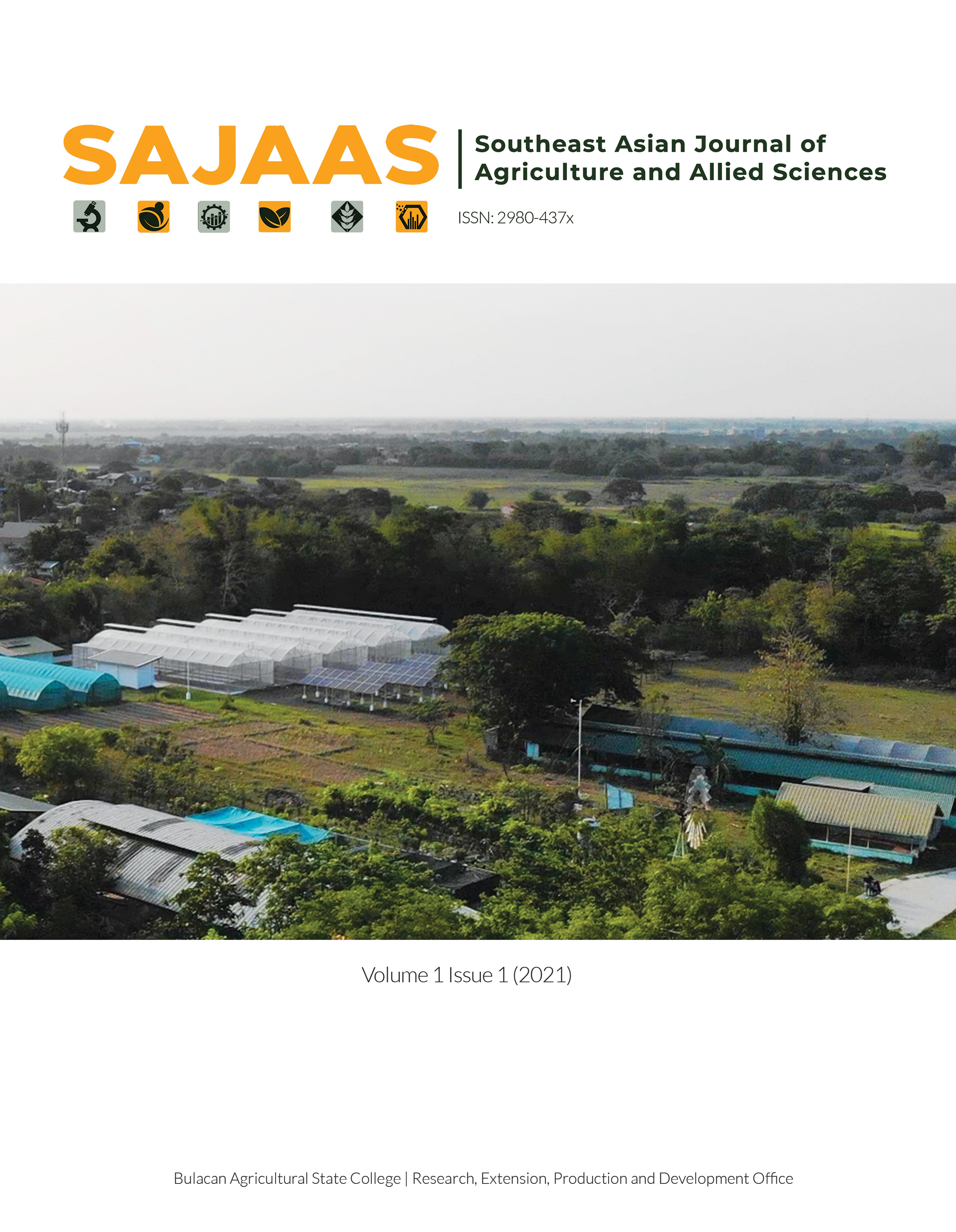Abstract
This study aims to develop fermented rabbit meat jerky. Lactobacillus casei strain Shirota (Lcs) from commercially available cultured drink was used as a starter culture. Samples of jerky were fermented at 3 h, 5 h, and 7 h. Parameters such as Lactobacillus count (CFU/g), pH, % titratable acidity, % moisture content, and water activity (Aw) were investigated. Results revealed that fermented rabbit meat jerky has a significantly lower pH than unfermented. Percent (%) moisture content and Aw of the fermented samples are found to be comparable to other dried fermented meats. However, no significant changes were observed in % titratable acidity among the jerky produced. The results of this study provide baseline data on the microbiological and physicochemical properties of rabbit meat jerky during fermentation.
References
Adams, M.R., & Moss, M.O. (2008). Food Microbiology (3rd ed). RCS Publishing. Cambridge UK
Adams, M. (2010). Fermented Meat Products. In Tamang,J.K. & Kailasapathy, K. (2010). Fermented Foods and Beverage of the World. CRC Press Taylor & Francis Group DOI: 10.1201/EBK1420094954-c11
Batt, C.A. & Tortorello M. L. (2014). Encyclopedia of Microbiology. (2nd ed). https://sciencedirect.com/topics/food-science/intermediate-moisture-food
Rodriguez-Calleja, JM., Santos, JA., Otero, A. and Garcia-Lopez, ML. (2004). Microbiological quality of rabbit meat. Journal of Food Protection, Vol. 67, No. 5, 2004, Pages 966–971
Cavani, C., Petracci, M., Trocino, A., & Xiccato, G. (2009) Advances in research on poultry and rabbit meat quality. Italian Journal of Animal Science, 8:sup2, 741-750, DOI: 10.4081/ijas.2009.s2.741
Fadlilah, A., Rosyidi D. and Susilo A., (2020) Microbial Qualities of Rabbit Meat Fermented with Lactobacillus plantarum. IOp Conf. Series: Earth and Environmental Science. doi:10.1088/1755-1315/492/1/012058
Food and Agriculture Organization. (2020). Effects of stress and injury and on meat by-product quality. http://www.fao.org/3/x6909e/x690e04.htm
FoodStruct, (2020). Summary information about Rabbit Meat. https://foodstruct.com/food/rabbit-meat#:~:text=and%20vitamin%20C.-,Minerals,%2C%20copper%2C%20zinc%20and%20 choline.
Food Safety and Inspection Service (2012). FSIS Compliance Guidelines for Meat and Poultry Jerky Produced by Small and Very Small Establishments. https://www.fsis.usda.gov/wps /wcm/connect/5fd4a01d-a381-4134-8b91-99617e56a90a/Compliance-Guideline-Jerky-2014.pdf?MOD=AJPERES
Hernández, P., Pla, M., & Blasco, A. (1996). Prediction of carcass composition in the rabbit. Meat science, 44(1-2), 75–83. https://doi.org/10.1016/s0309-1740(96)00078-2
Jay, J.M. (2000). Modern Food Microbiology. (6th ed.). Aspen Publication
Lornegan, S. M. & Marple D.N. (2019) Fresh and cured meat processing and preservation. The Science of Animal Growth and Meat Technology. https://www.sciencedirect.com/topics/food-science/restructured-meat#:~:text=Restructured%20meat%20products%20are%20ground,that%20of%20a%20ground%20product.
Kucerova, I., Stepan M.,and J. Banout. (2018). Solar Drying and Sensory Attributes of Eland (Taurotragus oryx) Jerky.Journal of Food Quality. https://doi.org/10.1155/2018/1067672
Lorenzo, J. M., Munekata, P. E., Dominguez, R., Pateiro M., Saraiva, J. A., & Franco, D. (2018). Main groups of microorganisms of relevance for food safety and stability. In Innovative Technologies for Food Preservation. https://www.sciencedirect.com/topics/agricultural-and-biological-sciences/lactobacillus-casei
Ockerman, H. W., & Basu, L. (2014). Production and Consumption of Fermented Meat Products. In Toldra, F., Hui, H. Y., Astiasaran I., Sebranek, J.G., & Talon, R., Handbook of Fermented Meat and Poultry. https://doi.org/10.1002/9781118522653.ch2
Philippine Food Composition Tables (2022). Rabbit white meat. Retrieved from https://i.fnri.dost.gov.ph/fct/library
Ray, Bibek (2005). Fundamental Food Microbiology. (3rd ed). CRC Press.
Sidira, M., Mitropoulou, G., Galanis, A., Kanellaki, M., & Kourkoutas, Y. (2019). Effect of Sugar Content on Quality Characteristics and Shelf-Life of Probiotic Dry-Fermented Sausages Produced by Free or Immobilized Lactobacillus casei ATCC 393. Foods (Basel, Switzerland), 8(6), 219. https://doi.org/10.3390/foods8060219
Veneracion M. (2017) An overview of the rabbit industry in the Philippines. http://agriculture.com.ph/2017/11/21/an-overview-of-the-rabbit-industry-in-the-philippines/
Wulandari, E., Yurmiati, H., Subroto, T. and Suradi, K. (2020). Quality and probiotic lactic acid bacteria diversirty of rabbit meat bekasam-fermented meat. Food Science of Animal Resources. Food Sci. Anim. Resour. 2020 May 40(3):362~376
Zalán, Z., Hudáček, J., Štětina, J. Chumchalova J., & Halasz A. (2017). Production of organic acids by Lactobacillus strains in three different media. Eur Food Res Technol .230, 395 (2010). https://doi.org/10.1007/s00217-009-1179-9
Zhao C, Shu L, Lu Z, Huang J, He S, Li Y. (2018). Optimization of pork jerky fermentation with Lactobacillus bulgaricus. J Food Safety.; 38:e12406. https://doi.org/10.1111/jfs.12406
Zhao X, Zhang, J, Ming H, Zou W, Wang Y. (2015). Research on pork jerky obtained through fermentation with Pediococcus acidilactic. http://journal.pan.olsztyn.pl

This work is licensed under a Creative Commons Attribution-NonCommercial-ShareAlike 4.0 International License.
Copyright (c) 2022 Southeast Asian Journal of Agricultural and Allied Sciences

